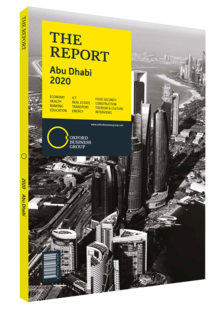Abu Dhabi's nuclear plant and an emissions-free future
In February 2020 the operating licence for the first unit of the civilian Barakah Nuclear Energy Plant was issued by the Federal Authority for Nuclear Regulation (FANR) to the plant’s operator, Nawah Energy Company, the operations and maintenance subsidiary of the Emirates Nuclear Energy Corporation (ENEC). The facility is the first of its kind in the Arab world and one of the largest nuclear plants under development.
The 60-year licence followed an assessment that reviewed the plant’s layout and the design, cooling system, security arrangements, emergency preparedness and radioactive waste management for the reactors. FANR will have regulatory oversight of the reactor, and has worked with the International Atomic Energy Agency (IAEA) to conduct international inspections. Approval of the licence was the final step before commencing the start-up process of the first reactor, the construction of which was completed in March 2018. As of December 2019 the construction of the second unit was 95% complete, with the third and fourth units 92% and 83% finished, respectively.
The $24.4bn plant, which will comprise four reactors upon completion, will add 5.6 GW to the grid and radically alter the energy mix. Importantly, nuclear energy will play a key role in diversifying electricity sources away from the traditional dependence on hydrocarbons. The UAE aims to increase the share of clean energy sources to 50% by 2050, with 6% to come from nuclear energy and 44% from renewables. The new facility will provide emissions-free baseload electricity to the grid, ensuring stability and enabling the integration of intermittent sources, notably solar.
Early Stages
The UAE took the first step towards the development of the segment in 2008, when it announced its intention to develop its nuclear capabilities for civilian purposes and forego domestic uranium enrichment or spent fuel reprocessing programmes. The following year, the UAE and the US signed a bilateral agreement for peaceful nuclear energy cooperation that included statutes on non-proliferation, safety and security. Under the agreement, the UAE singed up to the IAEA’s Additional Protocol inspections regime. In addition to its pact with the US, the UAE has signed nuclear cooperation agreements with an array of countries including Russia, Argentina and Japan. ENEC was established in December 2009 and charged with the development and ownership of the nuclear plant, with Korea Electric Power Corporation awarded the prime contract to construct the four units through to commercial operation. A site was chosen on the coast, around 53 km west of Ruwais, and, after the project received approval from the Environment Agency - Abu Dhabi (EAD) and FANR, construction began in 2012.
Safety System
The Generation III+ units feature a comprehensive range of safety systems and have been adapted to the UAE’s climate. These adaptations include larger pumps and heat exchangers, and a greater degree of ventilation given the high temperatures. Desert dust and sand also had to be taken into account during the design of the air-conditioning systems. The plant’s design considered the impact on marine life, with a refined intake tank screen close to the plant’s intake, and cooling facilities to protect local fish populations and ensure compliance with EAD’s regulations on seawater temperatures.
When all four reactors are on-line, Barakah will satisfy around a quarter of the UAE’s electricity needs without producing any carbon emissions, enabling a shift from natural gas-fired power stations. It will produce a steady supply of baseload electricity while preventing the release of 21m tonnes of C0 emissions each year, an annual reduction equivalent to taking 3.2m cars off the road. This will occur alongside the development of solar power, a source with inherent highs (daytime) and lows (night). Integrating the new energy sources will therefore require alterations in the electricity system, with further integration of the UAE and the region a potential outcome (see overview).
You have reached the limit of premium articles you can view for free.
Choose from the options below to purchase print or digital editions of our Reports. You can also purchase a website subscription giving you unlimited access to all of our Reports online for 12 months.
If you have already purchased this Report or have a website subscription, please login to continue.

